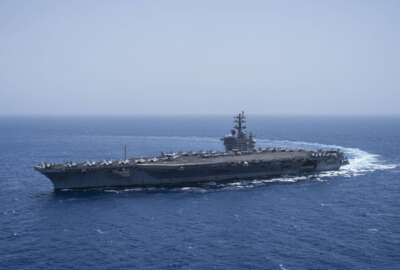Navy plans mandatory anti-sexual assault training for every sailor
Each sailor will be required to take a new round of training by the end of this year. Courses will emphasize the need for "bystander" servicemembers to intervene...
wfedstaff | April 17, 2015 3:56 pm
The Navy says it wants every sailor to get the message that it’s their job to intervene when they see a situation that’s creating the conditions for a possible sexual assault. So the service is instituting mandatory training that every servicemember, both active and reserve, will have to take by the end of the year.
Preparations will begin next week for the servicewide training, which will be split into two programs. One is tailored for Navy leaders, while a second curriculum is designed for deckplate sailors. Navy members who will become part of deployable training teams will start immersing themselves Monday in the curriculum the Navy developed with the help of an outside contractor.
From there, teams will begin travelling to areas with high Navy populations to begin passing the training onto Navy leaders through what the service is calling its Sexual Assault Prevention and Response for leaders program, or SAPR-L.
“It’s designed to create and design command climates that establish a zero- tolerance policy for sexual misconduct,” said Capt. Scott Seeberger, chief of staff for the Navy’s Sexual Assault Prevention and Response Task Force. “It will raise awareness among our leaders about the reality of sexual assault in our Navy, provide tools and techniques to prevent assaults, and educate leaders about their response roles in the event a sexual assault takes place.”
Every sailor holding the rank of chief petty officer or above will be required to take the two-hour leadership course, either in person, or in the cases of sailors in remote locations, through DoD’s Defense Connect Online service. Seeberger said teams will make in-person visits to nearly 100 sites.
The deadline for leaders to take the training is Sept. 30. Their next job will be to provide training to lower ranking sailors, through the separate Sexual Assault Prevention and Response-Fleet (SAPR-F) program. 
“We were just trying to get people aware of the problem,” said Rear Adm. Martha Herb, the Navy’s director of personnel readiness and community support. “Now, we’ve drilled down and hired an outside contractor to create a professional product. We filmed it on a ship, and we used actors and actresses to create a vignette of the process that happens in the continuum of harm. You see the precursors or the grooming behavior that occurs that might lead up to a sexual assault. It looks at the decisions that people on the ship have to make as to whether they should intervene or not.”
Senior Navy leaders say they’re extremely focused on the issue of sexual assault. There were 582 reported incidents in the service last year, a slight downtick from the year before. But the Navy’s top officer, Adm. Jonathan Greenert, said last week that the decrease wasn’t enough to provide any encouragement.
“I see a 7 percent decrease, but I don’t consider that significant,” he said. “I say, OK, we’ve got a lot of work to do.”
That work, Navy leaders say, includes getting every sailor to be as concerned about the issue as senior officials say they are. A key part of that, Herb said, is the concept of bystander intervention: educating every sailor about the warning signs of a situation that could lead to a sexual assault, and that it’s their responsibility to intervene in those situations.
“When they see their peer doing a behavior that will impact their career or the impact and well-being of another sailor, it’s our duty to interrupt that,” she said. “It can be a peer-to-peer intervention, but it can also be a peer to a senior person if it’s something that’s against our core values. We expect everybody in the ranks to be observant of the behavior they’re seeing. When they see something that’s against our core values, they need to step in and intervene because it’s the right thing to do.”
After all the Navy’s leadership is trained through the new program, they’re responsible for training each sailor in their command, with a deadline of no later than Dec. 31.
This story is part of Federal News Radio’s daily DoD Report brought to you by United Health Military and Veterans Services. For more defense news, click here.
RELATED STORIES:
Navy attempts culture change on sexual assaults
Military sexual assault survivors storm Capitol Hill
Mandatory breathalyzer tests coming to Navy, Marine Corps
Copyright © 2024 Federal News Network. All rights reserved. This website is not intended for users located within the European Economic Area.
Jared Serbu is deputy editor of Federal News Network and reports on the Defense Department’s contracting, legislative, workforce and IT issues.
Follow @jserbuWFED






